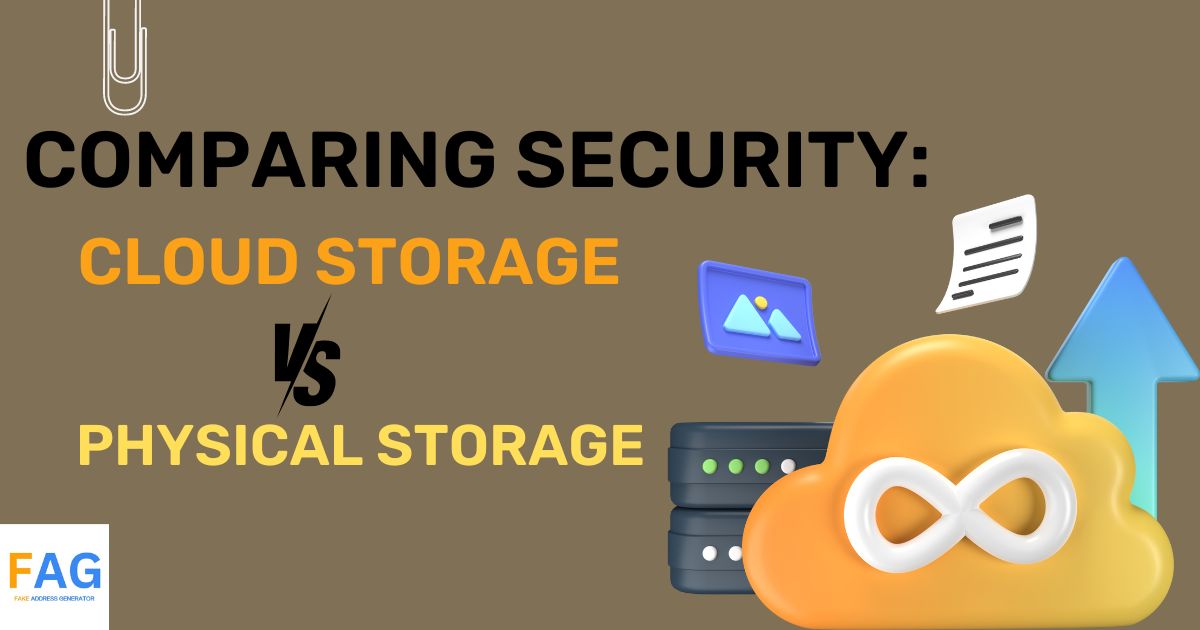Cloud storage and physical storage are two popular ways of storing data. While physical storage refers to saving data on devices like hard drives, DVDs, USB drives, and other portable storage options, cloud storage refers to storing data on remote servers that can be accessed from anywhere with an internet connection. Both types of storage have their advantages and disadvantages, but when it comes to security, which is better?

Security is a major concern for anyone storing sensitive or confidential data. When it comes to cloud storage, providers use encryption to ensure maximum fire safety. However, people are still skeptical about cloud storage due to the possibility of data breaches and hacking. On the other hand, physical storage gives you complete control over your data, and you know where it is and who has access to it. However, physical storage is also vulnerable to theft, damage, and loss.
In this article, we will compare cloud storage and physical storage in terms of security. We will explore the advantages and disadvantages of each method and provide tips on how to keep your data safe. Whether you are a business owner or an individual, understanding the differences between cloud storage and physical storage can help you make an informed decision about which option is right for you.
Understanding Cloud Storage and Physical Storage

Understanding Cloud Storage and Physical Storage” involves exploring the distinctions between storing data on remote servers (cloud storage) and local devices like hard drives or USBs (physical storage). This comparison covers aspects such as accessibility, control, security, and cost. By comprehending the advantages and limitations of each storage type, individuals and organizations can make informed decisions about which storage method best suits their needs for data access, safety, and management efficiency.
Defining Cloud and Physical Storage
Cloud storage is a mode of computer data storage in which digital data is stored on servers in off-site locations maintained by a third-party provider. The provider is responsible for hosting, managing, and securing data stored on its infrastructure. Cloud storage allows users to access data stored in the cloud from anywhere, as long as they have an internet connection.
Physical storage, on the other hand, refers to saving data on devices like hard drives, USB drives, and other portable storage options. With physical storage, users have complete control over their data, including where it is stored and who has access to it. Physical storage provides faster access speeds due to the absence of internet speed variables.
Types of Cloud Storage: Public, Private, and Hybrid
There are three types of cloud storage: public, private, and hybrid. Public cloud storage is provided by third-party providers, and users share resources with other users. Private cloud storage is used by a single organization, and the infrastructure is maintained by the organization or a third-party provider. Hybrid cloud storage is a combination of public and private cloud storage, where users can choose which data to store on which platform.
Common Physical Storage Devices
There are several common physical storage devices, including hard disk drives (HDDs), solid-state drives (SSDs), and USB flash drives. HDDs are the most commonly used physical storage devices, and they are used in desktop computers, laptops, and servers. SSDs are faster and more reliable than HDDs, but they are more expensive. USB flash drives are portable and convenient, but they have limited storage capacity.
In conclusion, both cloud storage and physical storage have their advantages and disadvantages. Cloud storage offers users the convenience of accessing their data from anywhere, while physical storage provides users with complete control over their data. Understanding the differences between cloud storage and physical storage is crucial in making an informed decision on which storage option to choose.
Advantages and Disadvantages

Pros and Cons of Cloud Storage
The increasing popularity of cloud storage highlights the significant benefits of cloud technology, and for good reason. Here are some of the advantages and disadvantages of using cloud storage:
Advantages
- Accessibility: One of the biggest advantages of cloud storage is accessibility. With cloud storage, users can access their files from anywhere with an internet connection. This makes it easy to share files with colleagues or work on projects remotely.
- Collaboration: Another advantage of cloud storage is collaboration. Many cloud storage providers offer collaboration features that allow users to work on files together in real-time.
- Scalability: Cloud storage is also highly scalable. Users can easily add more storage space as needed without having to invest in additional hardware.
Cons
- Cost: One potential disadvantage of cloud storage is cost. While many cloud storage providers offer affordable plans, costs can add up over time, especially for businesses or users with large amounts of data.
- Dependence on Internet Connectivity: Another potential disadvantage of cloud storage is dependence on Internet connectivity. Users need a stable and reliable internet connection to access their files, and slow or unreliable internet can impact their ability to access their data.
- Security: Security is also a concern with cloud storage. While many providers offer robust security measures, there is always a risk of data theft or loss.
Pros and Cons of Physical Storage
While cloud storage has its advantages, physical storage also has its benefits. Here are some of the advantages and disadvantages of using physical storage:
Advantages
- Control: With physical storage, users have complete control over their data. They can physically access their data at any time without having to rely on an internet connection.
- Maintenance: Physical storage also requires less maintenance than cloud storage. Users don’t have to worry about software updates or security patches, and they can easily replace or upgrade hardware as needed.
- Efficiency: Physical storage can also be more efficient than cloud storage in some cases. For example, users can quickly transfer large amounts of data between devices without having to rely on an internet connection.
Cons
- Space: One of the biggest disadvantages of physical storage is space. Users need physical space to store their hardware, which can be a challenge for businesses or users with limited space.
- Theft or Loss: Physical storage is also vulnerable to theft or loss. Users need to take extra precautions to secure their hardware and protect their data.
- Scalability: Physical storage is also less scalable than cloud storage. Users need to invest in additional hardware as their storage needs grow, which can be costly and time-consuming.
Security Measures and Risks
When it comes to comparing cloud storage and physical storage, security is one of the most important factors to consider. Both types of storage have their own security measures and risks. In this section, we will discuss the various security measures and risks associated with cloud storage and physical storage.
Encryption and Data Protection
Encryption and data protection are crucial security measures for both cloud and physical storage. Encryption is used to protect data by converting it into a code that can only be read by authorized users. Cloud service providers typically use encryption to protect data during transmission and while at rest. Physical storage devices such as external hard drives and USBs can also be encrypted to protect data.
Data protection is another important security measure that is used to prevent unauthorized access to data. Cloud storage providers typically have security protocols in place to protect data from cyber-attacks and unauthorized access. Physical storage devices can also be protected with two-factor authentication and other security measures.
Vulnerabilities to Cybersecurity Threats
One of the biggest risks associated with cloud storage is the vulnerability to cyber-attacks. Cloud storage providers are often targeted by cybercriminals who are looking to steal sensitive data. Cybersecurity threats such as malware, phishing attacks, and ransomware can compromise the security of cloud storage.
Physical storage devices are also vulnerable to cyber attacks, but the risk is generally lower than that of cloud storage. However, physical storage devices can be lost or stolen, which can compromise the security of the data stored on them.
Physical Damage and Natural Disasters
Physical damage and natural disasters are risks associated with physical storage devices. External hard drives and USBs can be damaged or destroyed, resulting in the loss of data. Natural disasters such as floods, fires, and earthquakes can also damage physical storage devices.
Cloud storage providers typically have measures in place to protect data from physical damage and natural disasters. Data is often stored in multiple locations, which reduces the risk of data loss due to a single point of failure. Cloud storage providers also typically have backup and recovery systems in place to protect against data loss.
In conclusion, both cloud storage and physical storage have their own security measures and risks. Encryption, data protection, and security protocols are important security measures for both types of storage. Cybersecurity threats are a major risk associated with cloud storage, while physical damage and natural disasters are risks associated with physical storage devices. It is important to consider these factors when choosing the best storage option for your needs.
Evaluating Costs and Management
Evaluating Costs and Management” involves assessing the expenses and administrative aspects of different systems or projects. This analysis helps determine the financial feasibility and operational efficiency of the options being considered. By comparing costs, such as initial outlays, ongoing expenses, and potential savings, alongside management demands like staffing, maintenance, and oversight, organizations can make informed decisions that align with their strategic goals and budgetary constraints, optimizing both resources and performance.
Comparing Costs of Storage Solutions
When it comes to evaluating the costs of cloud storage versus physical storage, there are a few factors to consider. Cloud storage, offered by cloud providers as a subscription service, can be more cost-effective for businesses that need to store a large amount of data. With cloud storage, businesses can pay for the storage they need on demand, which can be more cost-effective than investing in physical storage infrastructure.
On the other hand, physical storage requires businesses to purchase and maintain the infrastructure needed to store their data. This can include servers, hard drives, and other expensive hardware. Additionally, businesses need to consider the costs associated with managing and maintaining the infrastructure, including the cost of electricity, cooling, and IT staff.
Management and Accessibility Considerations
When it comes to managing and accessing data, cloud storage has a few advantages over physical storage. With cloud storage, businesses can access their data from anywhere with an internet connection, making it easier for employees to work remotely or collaborate with colleagues in different locations. Additionally, cloud storage providers often have redundant data centers, which can provide businesses with a high level of redundancy and disaster recovery.
Physical storage, on the other hand, requires businesses to manage and maintain their own infrastructure. This can be a significant undertaking, especially for small businesses that may not have the resources to invest in IT staff or infrastructure. Additionally, physical storage is often less distributed than cloud storage, which can make it more vulnerable to disasters or other incidents that could lead to data loss.
Ultimately, businesses need to evaluate their own needs and priorities when it comes to choosing between cloud storage and physical storage. While cloud storage can be more cost-effective and easier to manage, physical storage can provide businesses with more control over their data and infrastructure.
| Feature | Cloud Storage | Physical Storage |
|---|---|---|
| Accessibility | High (access from anywhere with internet) | Limited (access only from physical location) |
| Control | Lower (managed by third-party providers) | High (complete user control over data) |
| Security | High (encryption and advanced security protocols) | Moderate to high (depends on physical measures and risk of theft) |
| Cost | Variable (subscription-based, potentially more cost-effective) | Higher initial cost (requires purchasing and maintaining hardware) |
| Maintenance | Lower (handled by provider) | Higher (requires personal or business resources) |
| Efficiency | Dependent on internet connectivity | High (direct access without dependency on Internet) |
| Scalability | High (easy to increase storage space) | Low (requires additional physical hardware) |
| Risk of Data Loss | Lower (multiple backups and redundancies) | Higher (vulnerable to physical damage and disasters) |
| Vulnerability to Threats | Higher (target for cyberattacks but well-protected) | Lower (less targeted but vulnerable to physical theft) |
| Disaster Recovery | Excellent (data stored in multiple locations) | Poor (single location storage can be catastrophic) |
Frequently Asked Questions
What are the security risks associated with cloud storage compared to physical storage?
Cloud storage is often seen as a more vulnerable option due to the potential for cyber attacks. However, physical storage also comes with its own set of risks, such as theft or damage to the storage device. It’s important to carefully consider the security measures in place for both options before making a decision.
How do the costs of implementing security measures for cloud storage compare to those for physical storage?
The cost of implementing security measures for cloud storage can vary depending on the provider and the level of security needed. However, physical storage may require ongoing maintenance and upgrades to ensure the security of the data. Ultimately, the cost comparison will depend on the specific needs of the individual or organization.
What are the potential disadvantages of relying solely on physical storage for data security?
Relying solely on physical storage for data security can be risky. If the storage device is lost, stolen, or damaged, the data may be lost permanently. Additionally, physical storage may not provide adequate protection against cyber attacks or other digital threats.
Can cloud storage offer better protection against data breaches than local storage solutions?
Cloud storage providers often have more advanced security measures in place to protect against data breaches. However, it’s important to carefully research and compare different providers to ensure that the chosen option offers the necessary level of security.
What are the main differences in security protocols between cloud storage and local storage systems?
Cloud storage typically relies on encryption and other advanced security measures to protect data. Local storage systems may also use encryption but may not have the same level of security measures in place. Additionally, cloud storage providers may have more resources available to monitor and respond to security threats.
How does the risk of data loss or theft compare between cloud-based and physical storage options?
Both cloud-based and physical storage options come with risks of data loss or theft. However, cloud storage providers often have multiple backups and redundancies in place to protect against data loss, while physical storage may only have one copy of the data. Ultimately, the level of risk will depend on the specific storage solution and the security measures in place.










